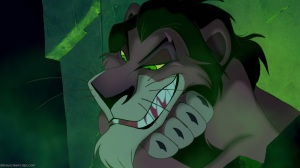The Lion King
Released 15/06/94
Directed by Roger Allers & Rob Minkoff
Written by Irene Mecchi, Jonathan Roberts & Linda Woolverton
Being as I am, a deftly sophisticated and terribly well read individual, I was in the car talking to my boyfriend about Shakespeare. Specifically, Hamlet. Specifically, how Hamlet was appropriated in the roughest sense to make Disney’s The Lion King (1994)
Fine. We were talking about The Lion King.
The Lion King Does have certain echoes of Hamlet in it. Namely, the uncle killing the father to steal his throne, and the son’s vengeance. There’s a ghost too, voiced by Darth Vader and showing up in the clouds over Africa. All good things. The Shakespeare appropriation goes further though, as The Lion King spawned a sequel based loosely off of Romeo and Juliet, and a third film that sits parallel to Rosencrantz and Guildenstern Are Dead (by Tom Stoppard). That last one is an appropriation of an appropriation of Hamlet; take a moment to wrap your brain around that and then let’s move on!
We were talking about all of this, when Boyfriend mentioned he often confused Hamlet with another Shakespeare play, Macbeth. Being the deftly sophisticated and terribly well read individual I am, I has a chuckle at this adorable peasant-like ignorance, and then had a thought. Maybe Boyfriend was on to something. Maybe The Lion King has a little more Shakespeare than first thought. Maybe, just maybe… Oh yes indeed. The Lion King is Macbeth from Scar’s point of view!
Mind. Blown.
Let’s examine this, shall we? Macbeth, set in Scotland, tells the story of, uh, Macbeth. Macbeth has a claim to the throne second to the King, Duncan. But Duncan undermines this claim and instead names his son as his successor. Macbeth (with a little prompting from three witches and his wife) murders Duncan, shifts the blame, and takes the throne. The son flees. Under his rule, Scotland is in chaos. Unwilling to abandon ship, Macbeth sticks it out to the bloody end, when the son returns, kills him, and reclaims his throne.
GEE. THAT SOUNDS FAMILIAR.
Scar was next in line for the throne, until Mufassa named his son Simba as his successor. Scar (with a little prompting from three hyenas) murders Mufassa, shifts the blame, and takes the throne. Simba flees. Under his rule, Africa is in chaos- no food, no water, nada. Unwilling to abandon ship, Scar sticks it out the the bloody end, when Simba returns, kills him, and reclaims his throne.
Disney, you clever minx.
There are a few obvious issues with this reading. The first is the witches. I have likened them, very loosely, to the hyenas, who are Scar’s assistants. The only real parallels are that there are three of them, they cackle and cause trouble, and they hail Macbeth/Scar as a king. However, it’s also worth noting that Shakespeare perhaps didn’t write the major witches scenes in Macbeth– Thomas Middleton probably did. The connection is lose, but forgivable.
Lady Macbeth is a more major raised eyebrow. She doesn’t have a parallel in The Lion King, which is a shame because she does play a rather pivotal role in the play. Arguably, this omission from the film can be justified by the way lion prides are structured, with one Alpha male that mates with all the ladies. Realism on this side, I think, justifies straying from the original text.
So there we have it! Children’s films proving yet again how complex and sneaky they can be. Simba is our Hamlet; Scar is our Macbeth. Let the word of Shakespeare live long, and prosper.
